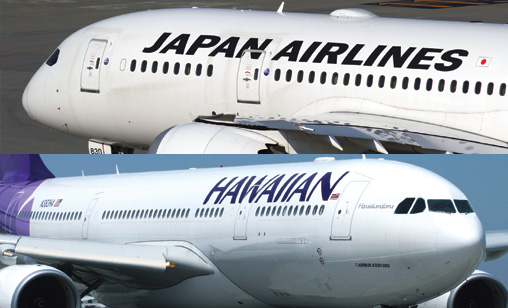News Backgrounder
Blossoming relationship
Japan Airlines and Hawaiian Airlines deepen their trans-Pacific partnership.
July 1st 2018
Japan Airlines (JAL) and Hawaiian Airlines have applied for anti-trust immunity to strengthen their relationship between the U.S. island state and Japan. Read More » It is Hawaiian’s biggest market outside the U.S. Mainland. The two airlines launched code-share services in March and want to extend co-operation to revenue-sharing on each other’s flights.
The two carriers pointed out that Star Alliance’s United Airlines and All Nippon Airways (ANA) and Skyteam partners, Delta Airlines and Korean Air, already operate immunized joint ventures. “Conferring the advantages of joint venture antitrust immunity to another U.S. carrier will strengthen the competitiveness of the U.S. airline industry and benefit the traveling public,” Hawaiian said.
 |
Hawaiian Airlines CEO, Peter Ingram, told Orient Aviation last month the carrier’s Japan traffic continues to grow. “We have added a Honolulu- Narita flight and now fly Haneda to Kona three times a week.
“We have grown to be the second largest carrier between Japan and Hawaii. The appeal of Hawaii to the Japanese is incredibly strong. There is an affinity that is unmatched by any destination in a foreign country that I have seen. I don’t know if there’s a parallel in the world,” he said.
The code-share arrangement allows Hawaiian to sell tickets through Jalpak, JAL’s package tour subsidiary that previously only sold JAL tickets. “Now, Jalpak is offering travel packages with Hawaiian tickets. We have had very good engagement at the working group levels (with JAL) to put the relationship together,” Ingram said.
“Culturally, there is a very good connection between the businesses. There is an alignment in our thinking that gives me confidence about the relationship’s future.”
The partners have some strong competition in the market. All Nippon Airways (ANA) is putting two A380s into service to exclusively serve the Japan-Hawaii market. Singapore Airlines-owned Scoot operates fifth freedom services from Singapore to Honolulu via Osaka and Malaysia’s AirAsia X does the same from Kuala Lumpur. AirAsia X will increase its flights to daily to Hawaii next month.
“That is a fair amount of capacity,” said Ingram. “We expected it to be a tougher market this year but it has held up better than forecast. Some of that success is testimony to the fact we have built our brand awareness since we first went into Japan in 2010.”
Like many carriers, Hawaiian has suffered from delayed deliveries of the A320neos. “If you go back to the original delivery scheme before any of the challenges, we were supposed to have three planes last year, eight planes coming this year, six in 2019 and one in 2020. We ended up with two airplanes delivered by the end of 2017. Instead of entering into service in the fourth quarter last year it was January of this year we started flying.
“We were about to get our third delivery in February when a couple of other airlines had issues with engines past a certain serial number. All deliveries stopped. For us it meant the drumbeat of deliveries expected in the early part of this year for the peak summer season were pushed back.
“We had to adjust our schedule because we did not have the aircraft to fly what we were selling. Most of the adjustments were from cities where we have another flight. We could accommodate people but not without disruption.
“Deliveries started again in May and we have had a pretty heavy schedule of deliveries in June and expect more this month and in August. We plan to have 11 A320neo at the end of the year. We have three at the moment. The planes are performing exactly as we expected. Fuel burn is fantastic. It’s a quiet airplane with low emissions. It is a 25-year asset and an asset that excites us.”
Hawaiian is flying three A321neo (13 more to come), 24 A330-200s, 20 B717-200s, eight B767-300ERs. It has ordered 10 B787-9s and has 10 options on the Boeing type. Long-haul expansion will commence after the B787-9s begin arriving at the carrier from 2021. Leases on some of the airline’s A330 fleet expire around the middle of the next decade which will give the carrier some flexibility in its fleet planning.
Hawaiian flies three times a week to Beijing, a service Ingram described as an “enormous long-term opportunity” but one that is taking time to build. “We would love to have better slot times. We would love it to be easier for Chinese nationals to obtain visas to the U.S. All these things will happen over time,” he said.
The Kilauea volcano eruptions have produced a small decline in demand, Ingram said. “The biggest impact has been on flights from Honolulu to Hilo and Kona, which are both located on the Big Island,” he said.
“One of our concerns, given our isolation, is people don’t understand the geography of Hawaii. It is a tragic event for people living there, but for most of the rest of us we are watching it on TV like everyone else. Honolulu is 150 miles away from it. Hilo airport and Kona airport have not been affected. Our operations have seen zero effect.”